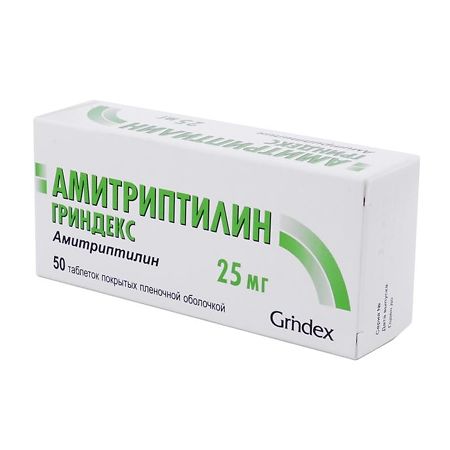No products in the cart.
Amitriptyline Grindex, 25 mg 50 pcs
€1.00
Out of stock
(E-mail when Stock is available)
Description
Depressed mood, Aggressiveness and conflict, Depression, Anxiety
Depression (especially effective for anxiety-depressive states), mixed emotional and behavior disorders, phobic disorders, childhood enuresis (except for children with hypotonic bladder), psychogenic anorexia, bulimic neurosis, severe pain of neurogenic nature, migraine prevention.
Active ingredient
Active ingredient
Composition
Composition
1 tablet containst amitriptyline (as hydrochloride) 25 mg;
10 pieces in blister,
5 blisters in carton box.
How to take, the dosage
How to take, the dosage
Internal, during or after meals. The initial daily dose is 50-75 mg (25 mg in 2-3 doses); if necessary, the dose is gradually (by 25-50 mg) increased to the optimal dose of 150-200 mg/day (most of the daily dose is taken before bedtime).
In severe depression resistant to therapy: 300 mg or more, up to the maximum tolerated dose. (Maximum dose for outpatients is 150 mg/day). After achieving a persistent antidepressant effect in 2-4 weeks, the dose is gradually reduced (in case of signs of depression it is necessary to return to the previous dose).
In mild disorders, in outpatient practice: in elderly patients 25-50 mg, maximum 100 mg in divided doses or once before bedtime.
Enuresis: in children over 6 years of age, 12.5-25 mg before bedtime (but no more than 2.5 mg/kg).
For migraine prophylaxis, in chronic pain of neurogenic character (including prolonged headache): from 12.5-25 mg to 100 mg/day.
Interaction
Interaction
Neuroleptics, sedatives and hypnotics, anticonvulsants, central and narcotic analgesics, anesthetics, alcohol potentiates the CNS depressant effect. Increases the hypertensive effect of catecholamines, blocks the antihypertensive effect of guanethidine and drugs with a similar mechanism of action. Cimetidine increases the plasma concentration of amitriptyline.
Combination with neuroleptics and/or anticholinergic drugs may cause febrile temperature reaction, paralytic ileus.
Special Instructions
Special Instructions
Simultaneous use with MAO inhibitors can be fatal. A break in treatment between MAO inhibitors and amitriptyline (and other tricyclic antidepressants) should be at least 14 days.
Amitriptyline at a dose above 150 mg/day lowers the seizure threshold, so there is an increased risk of seizures in patients with a history of seizures.
Driving, operating machinery, and other types of work requiring increased attention are prohibited during treatment.
The treatment of elderly patients needs to be carefully monitored, using the lowest doses of the drug, increasing them gradually.
The transition from the depressive phase of manic-depressive psychosis to the manic stage is possible.
If the patient’s condition does not improve within 3-4 weeks, further therapy is not advisable.
Contraindications
Contraindications
Hypersensitivity, toxic CNS depression, decompensated heart disease, acute and recovery period myocardial infarction, cardiac conduction disorders, degree III hypertension, acute liver and kidney diseases, blood diseases, Gastric and duodenal ulcer in acute stage, glaucoma, prostatic hypertrophy, bladder atony, pylorostenosis, paralytic ileus, concomitant use with MAO inhibitors, pregnancy, lactation, children under 6 years old.
Side effects
Side effects
Nervous system and sensory organs: accommodation disorder, increased intraocular pressure, drowsiness.
Cardiovascular system and blood (hematopoiesis, hemostasis): tachycardia, arrhythmia, orthostatic arterial hypertension, changes in blood count, including agranulocytosis.
Gastrointestinal disorders: stomatitis, taste disorders, anorexia, nausea, vomiting, epigastric discomfort, dry mouth, stool retention, bowel obstruction, liver function disorders (rare).
Other: skin rash, hair loss, enlarged lymph nodes, fever, gynecomastia, galactorrhea, altered ADH secretion, decreased libido, potency, weight gain with long-term use, urinary retention.
Overdose
Overdose
Symptoms: drowsiness, disorientation, confusion, dilated pupils, increased body temperature (fever), dysarthria, agitation, hallucinations, seizures, muscle rigidity, stupor, coma, vomiting, arrhythmia, arterial hypotension, heart failure, respiratory depression.
Treatment: discontinue therapy, gastric lavage, fluid infusion, intravenous or intravenous physostigmine 1-3 mg every 0.5-2 hours (children start with a dose of 0.5 mg, then the dose is repeated at 5-minute intervals to determine the minimum effective dose, but no more than 2 mg).
Fistostigmine should be used only in coma, respiratory depression, and other severe disorders; symptomatic therapy, maintenance of BP and water-electrolyte balance. Cardiovascular monitoring (ECG) for 5 days is indicated, as relapse may occur in 48 hours or later.
Similarities
Similarities
Additional information
| Shelf life | 3 years. |
|---|---|
| Conditions of storage | In a dry, light-protected place at a temperature not exceeding 25 °C. |
| Manufacturer | Grindex JSC, Latvia |
| Medication form | pills |
| Brand | Grindex JSC |
Related products
Buy Amitriptyline Grindex, 25 mg 50 pcs with delivery to USA, UK, Europe and over 120 other countries.












